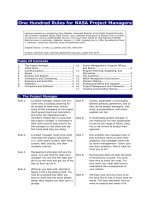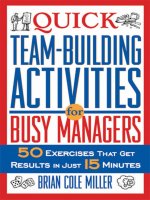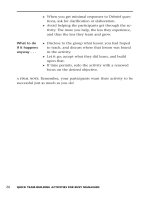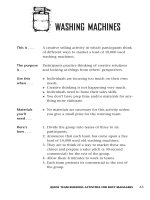Quick Team-Building Activities for Busy Managers: 50 Exercises That Get Results in Just 15 Minutes_5 ppt
Bạn đang xem bản rút gọn của tài liệu. Xem và tải ngay bản đầy đủ của tài liệu tại đây (227.06 KB, 19 trang )
For Additional sorting categories could be last name,
example . . . birthday (chronologically), favorite food, pet’s name,
length of time at current organization (numerically),
birthplace (alphabetically or geographically from east
to west), fantasy vacation destination, formal job title,
number of USA states visited in lifetime (numerically),
and so forth.
Ask these
➤ Why is it important for us to know each other
questions . . . beyond a purely work-related context?
➤ How difficult (or easy) was it to share information
about yourself with others?
➤ What surprises did you have when reorganizing
yourselves?
➤ How can we learn more about each other back on
the job?
Tips for ➤ Think of more categories than you think you will
success . . . need. It is better to have too many than not
enough.
➤ Stop the game when the energy or enthusiasm
starts to fade.
➤ This game can be played again with different cate-
gories or when a new member joins the team.
➤ You may use this activity to just get acquainted or
get a meeting started without asking the Debrief
questions afterwards.
Try these
➤ If the group is large (more than 24 participants),
variations . . . divide into three competing teams.
➤ Give small prizes for the team that is fastest.
➤ Halfway through the game, the teams combine
into one line for a category. Once they have
sorted themselves, divide them in half at the mid-
point of the long line. They now are two new
64 QUICK TEAM-BUILDING ACTIVITIES FOR BUSY MANAGERS
miller chap 04 7/24/03 3:38 PM Page 64
teams. Continue the game, and they get to know
new participants on their team.
➤ Keep the group in one group for all sorting.
➤ If the enthusiasm is high, ask the group to come
up with a category to try.
QUICK TEAM-BUILDING ACTIVITIES FOR BUSY MANAGERS 65
miller chap 04 7/24/03 3:38 PM Page 65
SIMILARITIES
AND DIFFERENCES
This is . . . An introductory activity in which participants are
challenged to find how they are similar and different
from each other.
The purpose Participants learn new and interesting things about
is . . . each other and connect with each other on a per-
sonal level.
Use this ➤ Individuals do not know each other very well.
when . . .
➤ A significant project or work effort is beginning.
➤ Individuals do not appreciate each other very
much.
Materials ➤ An index card (or sheet of paper) and a pen for each
you’ll participant.
need . . .
Here’s 1. Give each participant an index card and a pen.
how . . . 2. Have them divide their cards into three columns
headed by “Name, Similar, and Different.”
3. Have them mingle and try to fill their card with as
many names as possible.
4. For each name, they find something that they
have in common with the other person and one
way they are different.
66
QUICK TEAM-BUILDING ACTIVITIES FOR BUSY MANAGERS
miller chap 04 7/24/03 3:38 PM Page 66
For Name Similar Different
example . . . 1. Tim We love to travel. He likes country
music.
2. Benjamin We like to snuggle He speaks Spanish.
with loved ones.
3. Maria We watch She plays an
“The Simpsons.” instrument.
4. Gail We love to read. She doesn’t travel
much.
5. Wayne We lift weights He doesn’t have
regularly. any pets.
6. Heidee We love to cook. I don’t collect
anything.
Ask these
➤ How difficult (or easy) was it to share information
questions . . . about yourself with others?
➤ What surprises did you have finding similarities
and differences?
➤ How can we learn more about each other back on
the job?
Tips for
➤ Encourage the participants to not duplicate any
success . . . answers. If you find a second person with whom
you share a love of chocolate, try to find some-
thing else you also have in common with that
person.
➤ Encourage them to have their Similarities and
Differences be unrelated. For example, if the Simi-
larity is “we both love music,” rather than “he
likes rap and I don’t” as the Difference, try for
something unrelated to music altogether.
➤ You may use this activity to just get acquainted or
get a meeting started without asking the Debrief
questions afterwards.
QUICK TEAM-BUILDING ACTIVITIES FOR BUSY MANAGERS 67
miller chap 04 7/24/03 3:38 PM Page 67
Try these ➤ Limit similarities and differences to only work-
variations . . . related items or only personal items.
➤ Divide the group into teams of four to six partici-
pants. Have each team find one thing all members
have in common and where all members differ.
After a few minutes, shuffle the teams, and repeat.
68 QUICK TEAM-BUILDING ACTIVITIES FOR BUSY MANAGERS
miller chap 04 7/24/03 3:38 PM Page 68
SWEET STORIES
This is . . . An activity in which participants share a story about
themselves based on the color of the candy they
have in their hands.
The purpose Participants learn more about each other and learn
is . . . to trust each other a little more.
Use this ➤ One or more individuals are new to the group.
when . . . ➤ Individuals do not know each other very well.
➤ The group knows each other very well (see varia-
tion below).
Materials
➤ A large bag of M&Ms
®
, Skittles
®
, or other colored
you’ll candy pieces.
need . . .
Here’s 1. Have each participant take one candy.
how . . . 2. Do not eat it yet!
3. Take turns sharing with the group a story based on
the following code:
➤ Blue candy: A time at work when you felt very
proud.
➤ Green candy: A boss you respected and why.
➤ Yellow candy: A reason you are proud to belong
to this organization.
➤ Brown candy: An embarrassing moment at
work.
➤ Orange candy: A time at work when you failed.
QUICK TEAM-BUILDING ACTIVITIES FOR BUSY MANAGERS 69
miller chap 04 7/24/03 3:38 PM Page 69
➤ Purple candy: A funny thing that happened to
you at work.
➤ Red candy: A time at work when you were
scared.
4. Eat the candy.
Ask these ➤ Why is it important for us to learn about each
questions . . . other at work?
➤ How difficult (or easy) was it to share information
about yourself with others?
➤ How can we learn more about each other back on
the job?
Tips for ➤ Other categories can be used that relate more
success . . . closely to the workload, organization, or special
project.
➤ The stories do not have to be “the most” any-
thing—the most embarrassing, the most funny,
and so forth. Take that pressure away. Allow
participants to share the kind of story they are
comfortable sharing with the group.
➤ If you use a candy other than M&Ms
®
, be sure
to adjust the color coding to match the colors of
what you use.
➤ This activity can be repeated. Just ask for different
stories! Or start every meeting with one person
telling a story, and over time you will hear from
everyone.
➤ Limit the length of stories so no one monopolizes
the time.
➤ Post the story color code so participants can easily
match their candy to the story they need to tell.
Try these ➤ Divide larger groups (more than 12 participants)
variations . . . into smaller teams to share their stories with each
other.
70 QUICK TEAM-BUILDING ACTIVITIES FOR BUSY MANAGERS
miller chap 04 7/24/03 3:38 PM Page 70
➤ Remove the words “at work” for each color, and
get to know each other better personally.
➤ Divide the group into small groups of three to five
participants. Give them several minutes to share
their stories from one color. Select the best story
from the team, and share with the larger group.
➤ Use only two categories. Toss a coin to determine
which story to tell.
➤ For the group that knows each other very well,
have them tell the stories about each other rather
than about themselves.
➤ Get to know each other on a personal level along
lines such as these: one thing you learned from
your parents, why you like your favorite movie,
tell about your kitchen at home, pets you have (or
have had), and so forth.
QUICK TEAM-BUILDING ACTIVITIES FOR BUSY MANAGERS 71
miller chap 04 7/24/03 3:38 PM Page 71
This page intentionally left blank
CHAPTER 5
Cooperation:
Working Together
as a Team
miller chap 05 7/24/03 3:41 PM Page 73
CATCH!
This is . . . A fast-paced ball-tossing game where participants are
encouraged to improve the time it takes to pass the
ball around the group.
The purpose The group sees that improvements can always be
is . . . made on a process, and that it takes the whole team
to make process improvement work.
Use this ➤ The group needs to be looking to itself (rather than
when . . . the boss) for ways to improve.
➤ A feeling of arrogance (“We can’t get much better
than this!”) is strong in the group.
➤ Group members are not cooperating with each
other as well as they should.
Materials ➤ A Koosh
®
ball, beanbag, or similar item that is
you’ll safe to toss.
need . . . ➤ A stopwatch, watch, or clock with a second hand.
Here’s 1. Arrange the group in a large circle with every-
how . . . one standing.
2. Give the ball to anyone.
3. Ask him to throw the ball to anyone in the cir-
cle.
4. The catcher now throws the ball to someone else
in the circle.
5. This continues as each participant always throws
the ball to someone who has not had it yet.
6. The last one throws the ball back to the partici-
74
QUICK TEAM-BUILDING ACTIVITIES FOR BUSY MANAGERS
miller chap 05 7/24/03 3:41 PM Page 74
pant who had it first. The group has established
their Pattern.
7. Have them repeat the same Pattern throwing the
ball to the same person, in the same order as
they did before. Time them.
8. If anyone drops the ball, it goes back to the first
participant to start again. Time keeps ticking.
9. Announce the time, and ask them how much
faster they think they can get.
10. Repeat the Pattern, and time them again.
11. Give them 3 minutes to create a strategy to
vastly improve their time again.
12. Repeat the Pattern and time them again.
For There is no appropriate example for this activity.
example . . .
Ask these ➤ How did you feel the first time I timed you? On
questions . . . subsequent timings? (Nervous, energized, competi-
tive, pressured, etc.)
➤ What strategies did you employ to improve your
speed? How successful were they?
➤ What assumptions or limits did you impose on
yourselves? (We had to stay in the same circle order
we were in. We had to catch with our hands [not laps,
if sitting]; etc.)
➤ How did you feel when participant X dropped the
ball? (Frustrated, angry, depressed, hopeless, empa-
thetic, etc.)
➤ What was the key to your success?
➤ What implication does this have for us back on
our jobs?
Tips for ➤ Help them be successful. If they forget who gets
success . . . the ball next, remind them. Just be careful not to
take over leadership for the group.
QUICK TEAM-BUILDING ACTIVITIES FOR BUSY MANAGERS 75
miller chap 05 7/24/03 3:41 PM Page 75
➤ Be supportive of whoever drops the ball if the
group is not.
➤ Do not offer suggestions on how to improve; let
them struggle with it. One of the best ways is for
them to rearrange their positions in the circle!
➤ Watch, and listen to their comments during the
activity. Bring up relevant ones during the Debrief.
➤ Post the rules of the game so participants can refer
to them while they play.
Try these ➤ Establish two different patterns in the group with
variations . . . two different colored balls. Time them accomplish-
ing both patterns at the same time.
➤ Form two groups (each with one ball), and do them
simultaneously. See if the groups compete more
against their own time (which is the stated objec-
tive) or against each other’s times. Ask how the
competitive pressure helps or hinders their efforts
on the job.
➤ Make this more about dealing with change by
asking them to reverse the flow of the ball after a
round or two, but still maintain the same or better
speed.
➤ For smaller groups, have them also say their name,
a color, a company product, and so forth as they
toss the ball.
76 QUICK TEAM-BUILDING ACTIVITIES FOR BUSY MANAGERS
miller chap 05 7/24/03 3:41 PM Page 76
PASS THE CARD
This is . . . A quick moving activity in which participants pass
cards from one to another in a relay.
The purpose Teamwork and the competitive spirit energize
is . . . participants during times of change.
Use this
➤ The group needs an energizer before or during a
when . . . draining or very long meeting.
➤ Individuals would benefit from a shot of com-
petitiveness.
➤ Group members are not cooperating with each
other as well as they should.
Materials
➤ One deck of playing cards for each team.
you’ll
➤ A prize for the fastest team (optional).
need . . .
Here’s 1. Divide the group into teams of four to eight
how . . . participants.
2. Each team sits on chairs in a line side by side.
3. Place a deck of cards on the floor next to the
chair at the far right end of each team’s line.
4. Give the instructions, and allow teams 5 minutes
to plan their strategy.
5. To play, the participant nearest the deck picks up
a card.
6. He then passes the card from his left hand to the
right hand of the participant to his left.
QUICK TEAM-BUILDING ACTIVITIES FOR BUSY MANAGERS 77
miller chap 05 7/24/03 3:41 PM Page 77
7. The second participant passes that card to her
left hand, then on to the right hand of the next
participant.
8. Play continues like this until the last participant
places the card in a pile on the floor next to her
with her left hand.
9. No one may hold more than one card at a time.
10. The first team with all cards stacked at the end
of their line wins.
For As soon as the first participant gets rid of that first
example . . . card, he can reach down and get the next one to
start passing. He does not have to wait for the first
card to travel all the way down his line.
Ask these ➤ How did you determine your strategy? Did it
questions . . . work?
➤ How did you feel when a participant dropped a
card? (Angry, worried about time, impatient, frus-
trated, empathetic, etc.)
➤ Which strategies worked best?
➤ When do we have to be this much in sync at
work?
➤ What implications does this have for our team
back on the job?
Tips for ➤ Use this opportunity to mix the group up. Arrange
success . . . teams so that participants who do not normally
work together are on the same team.
➤ As much as possible, have the teams lined up so
they can easily see each other. This will increase
the competitive nature and also provide dis-
tractions!
➤ Post game rules so participants can refer to them
during play.
78 QUICK TEAM-BUILDING ACTIVITIES FOR BUSY MANAGERS
miller chap 05 7/24/03 3:41 PM Page 78
Try these ➤ Make this more difficult by blindfolding some
variations . . . (just the first and last?) or all participants.
➤ Items other than the cards may be used: pennies,
paperclips, items unique to your workplace, and
so forth.
➤ Make this more difficult by using pads of sticky
notes. Require that the pad be reconstructed at
the end of the team line!
QUICK TEAM-BUILDING ACTIVITIES FOR BUSY MANAGERS 79
miller chap 05 7/24/03 3:41 PM Page 79
POPCORN
This is . . . A fun activity in which participants, working in
pairs, feed each other pieces of popcorn on a spoon
while both are blindfolded.
The purpose Participants learn to cooperate with each other, have
is . . . fun, and reinforce communication skills.
Use this
➤ Individuals need to slow down and focus.
when . . .
➤ Individuals are not being creative at problem solving.
➤ The group needs to loosen up, have some fun, and
laugh.
Materials ➤ A blindfold for each participant.
you’ll
➤ A spoon for each participant.
need . . .
➤ Popcorn.
Here’s 1. Have the participants pair up.
how . . . 2. Distribute blindfolds, spoons, and popcorn to
everyone.
3. While both are blindfolded, one participant feeds
10 pieces of popcorn to his or her partner on the
spoon one at a time.
4. After they are successful, reverse roles and repeat.
For There is no appropriate example for this activity.
example . . .
Ask these
➤ How did you feel when you put on the blindfold?
questions . . . (Nervous, disoriented, etc.) Why?
80
QUICK TEAM-BUILDING ACTIVITIES FOR BUSY MANAGERS
miller chap 05 7/24/03 3:41 PM Page 80
➤ What happened as you tried to feed each other?
(Popcorn kept blowing off the spoon; She jabbed my
nose with the spoon; I had to feel my way; etc.)
➤ What ways did you find to communicate, coop-
erate, and be successful? (Touch, frequent feedback,
overhearing what someone else did that worked, etc.)
➤ What implications does this have for us back on
the job?
Tips for ➤ Prepare by putting small amounts of popcorn in
success . . . plastic bags for each participant. Some of the pop-
corn will be dropped, so put more than 10 pieces
in each bag!
➤ Supply something other than popcorn if you
know someone is allergic to it.
➤ Watch to see if anyone cheats with the blindfolds.
When is it appropriate to break the rules?
Try these ➤ Easier, and perhaps tastier, would be small candies.
variations . . .
➤ Have the participants alternate feeding each other
one piece of popcorn instead of all 10 in a row.
➤ Divide the group into teams of three or more, and
have each team member feed the popcorn to the
person on the right simultaneously. This is much
more difficult and requires much more coopera-
tion and teamwork.
➤ Use forks to stab the popcorn, instead of spoons.
QUICK TEAM-BUILDING ACTIVITIES FOR BUSY MANAGERS 81
miller chap 05 7/24/03 3:41 PM Page 81
PUZZLED
This is . . . An activity in which participants learn, as they as-
semble a puzzle, that other teams have some pieces
they need, and they have pieces others need.
The purpose Participants see that cooperation across real or
is . . . perceived team boundaries can be beneficial (some-
times even crucial) for success.
Use this ➤ The group needs to cooperate within itself or with
when . . . other groups to be successful.
➤ Competitiveness is hindering team efforts.
➤ Individuals are asking the boss to solve their prob-
lems for them.
Materials
➤ One children’s puzzle for each small group, prefer-
you’ll ably with 20–50 pieces.
need . . .
➤ A bag (or box or envelope) for each puzzle’s pieces.
➤ Assemble the puzzle bags in advance (without the
group knowing you have done this):
a. Place all the puzzle pieces for each puzzle in a
separate bag.
b. Line up the filled bags in front of you.
c. Remove two to three pieces from each bag.
d. Place those pieces in other bags, each piece in a
different bag.
Here’s 1. Divide the group into teams of three to six partici-
how . . . pants. There must be the same number of teams as
you have bags of puzzles.
82
QUICK TEAM-BUILDING ACTIVITIES FOR BUSY MANAGERS
miller chap 05 7/24/03 3:41 PM Page 82









